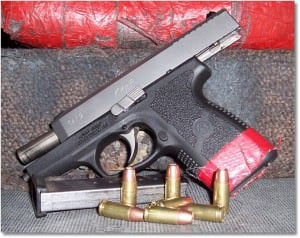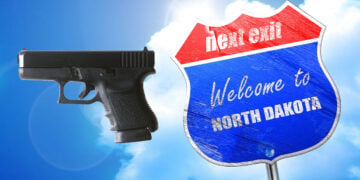
After reading many reviews, I finally took the time to shoot the Kahr CW9 at the range.
I’ve been seriously considering another summer carry in 9mm and the Ruger LC9 and Kahr CW9 were being considered and in the running for top spot. It also means that I will be trading in a gun to help finance the chosen one; something that I’m not happy about doing but such things have to be done at time.
Unfortunately, the range did not have a Ruger LC9 range gun, but they did have the Kahr CW 9. So, I would like to share my impression of the gun with you while fully noting that some of you actually own and carry this gun. So, you may or may not agree with me on some points – but that’s alright.
I’m trying not to compare the Kahr with a Glock or any other gun; I want it to stand on its own merits and it has quite a few going for it.
First the basic specs (those who know these by heart, bear with me)
- Caliber: 9mm
- Capacity: 7+1
- Operation: Trigger cocking DAO; lock breech; “Browning – type” recoil lug; passive striker block; no magazine disconnect
- Barrel: 3.6″, conventional rifling; 1-10 right-hand twist
- Length O/A: 5.9″
- Height: 4.5″
- Slide Width: .90″
- Weight: Pistol 15.8 ounces, Magazine 1.9 ounces
- Grips: Textured polymer
- Sights: Drift adjustable white bar-dot combat rear sight, pinned in polymer front sight
- Finish: Black polymer frame, matte stainless steel slide
- Magazine: 1 – 7 rd, Stainless
Here is the range gun that I used:

The ammunition I used was 124 grain Jacketed Hollow Point (1100 FPS) as supplied by Georgia Arms.
This was going to be a test and familiarization run; no accuracy trials, no speed runs, no precision runs.
My first impression upon receiving the gun how light it was. With magazine this thing weighs out at 17.7 ounces empty. Not bad.
The second thing that I noticed was that it fit my hand very well. I’m used to handling pistols that have thick as well as fairly skinny grips and this was no exception. I would; however, be fitting a Pachmyr Tactical Gun Sleeve to help thicken the grip to my hand a little and to offset the aggressive stippling on the handle of the gun (more on that later).
I like the 7+1 capacity and the magazines are slim enough to carry several spares on your person. The magazine has a “Pinky catch” and it did that with my hand. (Note: I do not use the little finger when gripping. It’s just something that I broke myself of for the most part, but I do catch myself uses the pinky from time to time)
The sight setup on this particular gun had a red-dot front sight with a simple vertical bar in the center of the rear sight. I think that they call this a “Bar-Dot Combat” sight. I call it the “Dot-the-I” sight arrangement.
The slide stop lever is predominant and easy to actuate with the thumb of the shooting hand without shifting too much of the grip.
Although the gun has a “Chamber-Loaded” indicator on the right side, it was about useless to me. My hands are not rough from typing too many letters but I could not really tell a difference in it when I ran my finger across it when the gun was loaded as when I did the same with the gun unloaded. I don’t need it to tell me when the gun is loaded anyway.
The magazine release is comfortably located and takes no effort to push it. I found that I did lose some grip when pushing it to release the magazine, though. A grip sleeve might help in that area for me.
I did a dry fire several times to acclimate myself to the sights and the trigger.
The trigger is very smooth and surprisingly short. I had expected a longer pull. My trigger finger is not cramped when the striker is released. I only wish that it had a “slack-point”, a point just to when it ready to fire, the pressure seems to ease up a bit, which tells you that the striker is about to be released. I could not find the trigger’s reset point – if there is one. Perhaps more familiarization time with the gun may help me discover if there is a trigger rest point or not.
Loading up the first magazine I noticed that some of the rounds did not look like they seated properly. Upon closer inspection I noticed that as I loaded each round I could feel a click as the rim of the cartridge passed by a point in the magazine; the base of the cartridge was flush with the back of the magazine. If I didn’t ensure that this “click” was felt, the cartridge would still load but would not be seated in the magazine fully. Maybe, that was me. Perhaps some owners of this gun can enlighten me on this point.
With that being said, the magazine was easy to load and did not require a “helper”. I did notice that the edges of the top lip of the magazine were somewhat sharp. They did not cut my thumb but they did poke at it a bit.
It was time to shoot the CW9.
The face of the trigger is smooth. While a lot of people like smooth trigger, I find that a grooved trigger help me position the pad of the trigger finger on the trigger better. But, it’s not a deal breaker if a gun has a smooth-faced trigger.
Recoil from the first shot was snappy, but manageable. I would have to be a little more aggressive with my grip. Since the grip felt slim in my hand, the grip sleeve might help me out her.
The gun cycled perfectly and did not skip a beat. I was not looking for groups; I was looking for point ability. I was aiming at an imaginary point on the target, pull the trigger, and see how close I could get to that image. The first six shots were shot low to get a general feel for the trigger. I then started moving toward center mass and then to the head. After about 20 rounds, I was starting to get a feel for the gun. I had only brought 50 rounds with me so I had to be a quick study. One point, one shot.
Point to a spot in the throat area get a flash sight picture and pull the trigger. Move to the upper chest, flash sight picture, pull the trigger. Move to a head shot, flash sight picture and pull the trigger. Just take different points and try to hit it. Move up and down the body using 9mm acupuncture techniques.
I pulled four shots out of the main area that I was working in when trying to fast fire and not being used to the trigger, but all in all the gun did what it was told to do and I was satisfied with my first introduction to this pistol.
Now, by the time all 50 rounds had been shot, the stippling on the back of the grip was getting to the web of my shooting hand a little. For me, a grip sleeve (possibly a Pachmyr Tactical Grip Sleeve with finger grooves?) may provide me with a better grip.
My impression of the Kahr CW9 is favorable. It’s not a Glock or a Springfield or a Ruger. It is what it is – a quality handgun that I would carry without reservation.
I’m sure that you Kahr CW9 owners feed your gun its favorite ammunition. I’d like to hear from you on this.
I can’t help myself:
While the initial report was intended to be a “stand-alone” review of the Kahr CW9, I am also cognizant that comparisons between the CW9 and other pistols (and revolvers) is inevitable as most of us have carried a variety of pistols and revolvers.
In all reality, I hope to see comparison comments that will open discussion
One point that I forgot to make in the initial write-up is that, in my opinion, the CW9 is not a “beginners pistol”. It will take time and practice to master the somewhat long, but smooth, trigger pull in order to place shots accurately and with consistency – as it does with a double-action revolver. An advantage is that you do not have that DA to SA transition, which cause a lot of shooters with DA/SA pistols to throw away that first shot (I don’t mean literally throw away but simply the first round does not hit the intended mark).
I like the trigger on the Ruger LC9 better, although the pull is longer than the CW9s. The trigger pull on the Ruger is reminiscent of long double-action revolver triggers. The trigger on the Ruger LC9 has (what I call) a “slack point” as is found on many double-action revolvers. Watching the hammer on the LC9, the slack point comes when the face of the hammer is about equal to the top of the slide; there is just a bit of slack just before the hammer falls. Once I found the slack point, I could hold that hammer position all day. When ready to fire, the hammer drops with just a little bit more pull.
The slack point in a revolver was that last opportunity to make sure the sights were aligned with what you wanted to hit. I learned to use that slack point to my advantage on many occasions during some friendly non-timed competition where hits in the 5x circle meant taking home a trophy or not.
I found the CW9 to be a good “instinctive” shooting gun. That is, I could focus on a spot that I wanted to hit and, without using the sights, come close to hitting it. That tells me a lot about the ergonomics of the gun; the gun becomes an extension of the hand instead of a foreign object held in one’s grip. Instinctive shooting lends a lot to ‘combat accuracy’ when you are trying to win the heart and mind of the enemy – two rounds to the heart and one round to the mind.
The one thing that I did not try was one-hand shooting. Due to the thin grip, a two-handed hold was essential for me. The same holds true with the LC9, as it does with my G36. With my G36, a grip sleeve helped immensely in that department and I have no problem shooting the G36 one-handed. It’s not that I have large hands, it’s that I have somewhat long fingers and need either additional length or width in the grip area (A Beretta 92FS with Pachmyr finger-grooved grips is a perfect fit in my hand). A person with shorter or thicker appendages may not have a problem at all with the CW9’s grip.
As with anything, tradeoffs are to be made.
I’m looking forward to reading responses from more users of this gun.









